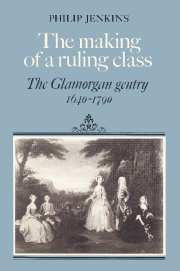Book contents
- Front matter
- Contents
- List of maps and tables
- Acknowledgments
- Abbreviations
- General introduction
- PART I SOCIAL AND ECONOMIC STRUCTURE
- Introduction
- 1 Land and people
- 2 The gentry
- 3 Economic development
- Conclusion to Part I
- PART II LOCAL AND NATIONAL POLITICS
- PART III SOCIETY AND CULTURE
- Conclusion to Part III: ‘conspicuous antiquity’
- Aftermath: towards the Victorian world
- Conclusion: from Civil War to Industrial Revolution
- Appendix 1 Parliamentary service by Glamorgan landowners 1640 – 1800
- Appendix 2 The ‘secondary’ gentry families
- Appendix 3 The ‘tertiary’ families
- Appendix 4 The Mansell family and their connections with the greater gentry
- Appendix 5 The roundhead and puritan family links of the Thomases of Wenvoe
- Notes
- Index
3 - Economic development
Published online by Cambridge University Press: 22 September 2009
- Front matter
- Contents
- List of maps and tables
- Acknowledgments
- Abbreviations
- General introduction
- PART I SOCIAL AND ECONOMIC STRUCTURE
- Introduction
- 1 Land and people
- 2 The gentry
- 3 Economic development
- Conclusion to Part I
- PART II LOCAL AND NATIONAL POLITICS
- PART III SOCIETY AND CULTURE
- Conclusion to Part III: ‘conspicuous antiquity’
- Aftermath: towards the Victorian world
- Conclusion: from Civil War to Industrial Revolution
- Appendix 1 Parliamentary service by Glamorgan landowners 1640 – 1800
- Appendix 2 The ‘secondary’ gentry families
- Appendix 3 The ‘tertiary’ families
- Appendix 4 The Mansell family and their connections with the greater gentry
- Appendix 5 The roundhead and puritan family links of the Thomases of Wenvoe
- Notes
- Index
Summary
Introduction
I have referred to the elite families as ‘great gentry’ in the context of Glamorgan, but this does not suggest their status relative to landowners from elsewhere in Britain. Wales was proverbial for poor but proud gentlemen who would have been dwarfed by even the yeomen of Kent or Norfolk. In Caernarvonshire or Merionethshire in the early eighteenth century, an annual income of only £800 was very rare, at a time when this would not have put most English squires in the first rank of their communities. A typically Welsh pattern was that of Radnorshire, where the saying went:
'Alas alas poor Radnorshire
Never a park, not even a deer,
Never a squire of five hundred a year
Save Richard Fowler of Abbey Cwm-hir.'
But as so often, we find that Glamorgan followed English rather than Welsh patterns. If we take the English criterion of ‘great gentry’ as those possessing annual incomes of about £1,000 in the 1670s (£2,000 about 1710) then about fifteen Glamorgan estates would qualify. This community was not dissimilar in wealth from Dr Roebuck's sample of Yorkshire baronets; and (it will be argued) at least equal to many European aristocrats.
This chapter examines the means by which the wealth of the gentry rose dramatically during the eighteenth century, and stresses both demographic factors and improved estate administration.
- Type
- Chapter
- Information
- The Making of a Ruling ClassThe Glamorgan Gentry 1640–1790, pp. 44 - 70Publisher: Cambridge University PressPrint publication year: 1983

